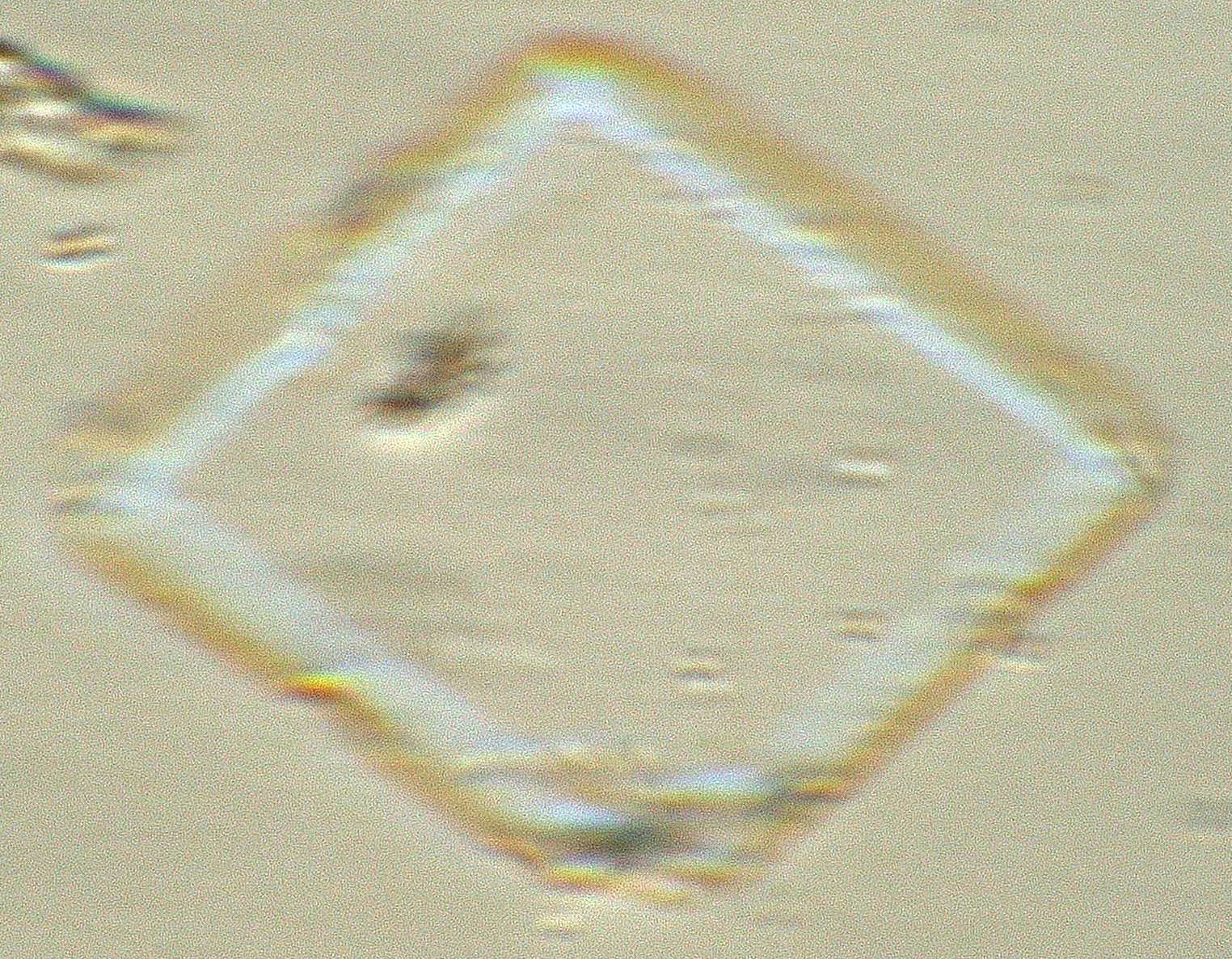Calcite in 1.664
This is a calcite crystal in a mounting medium of 1.664 refractive refractive index index medium with the linear polarizing filter aligned with the omega direction (bisecting the acute angle). The colors here indicate a refractive index match at a wavelength of approximately 560 nm. The crystal has higher refractive indices for wavelength in the orange and red and the liquid has higher refractive indices in the green and blue end of the spectrum. These are the Becke' lines seen as the particle is defocused by moving closer to the objective.
Definition/Function:
Dispersion Staining is an optical staining technique created by differences in the dispersion of the refractive indices for a particle and the liquid in which it is mounted. Becke` Line dispersion staining is one of the five methods of dispersion staining. It was first documented by F.E. Wright in 1911. It is used primarily as a screening technique or for large particles. For smaller particles or when looking for a specific mineral the other methods of dispersion stain generally work better.Conditional Requirments:
This approach works best with a mounting medium that has a steep dispersion curve. Most liquids with refractive indices above 1.60 meet that requirement. There are "high dispersion" liquids sold commercially designed specifically for dispersion staining. These sets normally start at a refractive index of 1.500 and go up to about 1.700. The particles of interest are mounted in one of these liquids that matches the refractive index of the particles at some visible wavelength. High dispersion liquids can also be made by mixing cinnamic aldehyde (R.I. about 1.62) with triethyl phosphate (R.I. 1.406), or methylene Iodide (R.I. 1.737). A less expensive set of high dispersion liquids can be made with cinnamon oil, also called cassia oil (R.I. about 1.60) and clove oil (R.I. about 1.53) or caster oil (R.I. about 1.48). These oils can generally be purchased at any local drugstore. When liquids are mixed it is good to test them against standard glasses or minerals on a regular basis. The commercial refractive index liquids are designed for long term stability.
The particles must be mounted under a coverslip to optimize the effects and minimize in interference cause by any optical anomaly in an unmounted specimen.
Microscope Configuration:
Begin by establishing Koehler Illumination and then close down the sub-stage condenser iris. Defocusing the particle brings the colored Becke` Lines into view.Characteristic Features:
The advantage of this technique is that no accessories to a standard microscope are required for its use. A disadvantage of this technique is that the particle must be move from its optimal focal position to see the effect. In a field cluttered with particles it can be difficult to be certain of the particle producing the effect. Image resolution is sacrificed and depth of field is increased by closing down the sub-stage condenser iris. This further complicates the isolation of one particle in field full of particles.References:
Deer, W.A, R.A. Howie, and J. Zussman, "Calcite", AN INTRODUCTION TO THE ROCK FORMING MINERALS, 2nd Edition, Longman Scientific and Technical, pp. 623-632, 1992.Wright, F. E., The Methods of Petrographic-Microscopic Research. Their Relative Accuracy and Range of Application, Pub. No. 158, Carnegie Inst., Washington, 1911.


